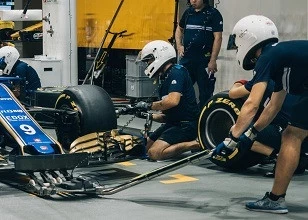Seven Questions Leaders Should Ask Before Starting Process Improvement
Add bookmarkHistory tells us that for sustained continuous improvement it's the long term strategies that keep delivering, writes Phil Brown, Business Excellence Manager at Pattonair. So don’t even think about starting process improvement until you ask yourself these seven questions.
Over the years I have led, reviewed, analyzed or taken part in many improvement programs, both in my roles for companies and as an EFQM (European Foundation for Quality Management) Assessor. Looking back on my time I have tried to think of the crucial questions that I would suggest leaders ask themselves before starting on their journey (first hint!)
I am not offering this as a panacea for preventing all problems but I do believe in the carpenters idiom ‘measure twice, cut once’ and therefore propose these as some ‘measuring time’ before you start cutting!
Question 1: Do I really think that I can change the world in 3 months?
‘Of course I do, how do you think I came to be in charge of this facility, business etc? I make things happen and this initiative will be no different!’
History tells us that whilst short term actions can lead to some gains, in the world of sustained continuous improvement then it is the long term strategies that keep delivering.
Reviewing failed change initiatives (and there are thousands to choose from!) will all show that unrealistic expectations of what can be delivered in a short time leads to lack of continued focus and active participation. It seems more to be ‘well that didn’t work – what quick fix can we try next?
Reviewing successful change programs (and they are out there if you look!), shows that If you truly want to develop and embed continuous sustainable improvement then stop thinking of weeks or months and start thinking about how you will support and sustain it over the coming years.
Question 2: Do I really have the time/interest/determination to see this through in the long term?
‘What do you mean do I have the time interest and determination to see this through? I will tell my team what is expected, delegate to them and sit back and wait for the improvements or benefits to flow’.
Any serious review of failed change initiatives shows that the number 1 cause of failure is a lack of focused and active support from senior management. With all of the other pressures on leaders/managers from day to day pressures there is a constant threat of putting improvement on the back burner.
Using the quadrants of time from Stephen Covey’s excellent book, the 7 Habits of Highly Effective People, it is clear that continuous sustainable improvement is firmly in quadrant 2 – important but not urgent. Therefore, unless it is constantly reviewed, nurtured and proactively supported then your improvement initiative will quickly fade into the background as you continue to focus on quadrant 1 – urgent and important (fire fighting)
Question 3: Have I got the right people with the right skills, tenacity and time to lead this activity across the business?
‘Of course I have, they have all been hand picked to ensure that they can deliver to tight deadlines and do as they have been told’
Another one of the crucial elements of effective implementation of change is ensuring that you have the right blend of skills and abilities in your team to meet all of the required needs. Thinking about the skills set out by Belbin, it is clear that having only one set of characteristics in your team is a recipe for real problems. As someone who has had the experience of working with a senior management team (in a previous company) where 6 out of the 7 team members were Shapers (highly motivated – and opinionated – task leaders) then I can tell you that is a real eye opener in how not to get things followed through!
In your team you will need a senior champion who has the vision, character and abilities to support the initiative through all stages/phases of the program. It is highly likely that they will need to be full time on this program if you really mean to succeed. They will not be someone who it will be comfortable to spare but is likely to be one of your key players.
Many organizations delegate this key role to someone who is ‘spare’ at the moment or just add this role to their already full work life. Either way, don’t expect much success – again, history tells us that this is a clear path to failure.
Underneath this champion will be several other roles, experts, trainers, facilitators etc – all of whom will need to be identified, trained, released from other tasks and supported. However, without the Champion they will be rudderless and likely to expend lots of energy, enthusiasm and resources in delivering little.
Question 4: How will I ‘sell’ this to both the leadership team and the troops?
‘All the leadership team wants to hear is how fast we can deliver benefits so that is what I will tell them. If I start trying to explain how long this is going to take and how much investment we will need to make then they will just switch off’
‘All the ‘troops’ want to hear is what they will get out of it so I will exaggerate the benefits and play down the hard work that will be needed – they will be happy then’
Hopefully from the previous questions it is really sinking in just how hard it is to make sustained continuous improvement work. There is little point in setting out with false expectations – both for the leadership team and the troops. The initiative needs to be openly and honestly discussed:
What will the journey will look like?
What sorts of time scales are involved?
What issues can be expected along the way?
What is the level of commitment from the organization?
What is expected from everyone?
What benefits can be expected – and when in the program?
Does the organisation really mean business or is this just another ‘quick fix’?
What will the organisation and its people look like at the end of each phase (remembering that there is no end to this journey)?
Question 5: What happens when the going gets tough and I have other priorities to deliver on?
‘It must be understood that our first priority is to get our deliveries out of the door – if we have to cancel or postpone some meetings or activities then that is just what happens’ or ‘Yes this initiative is important but it cannot be allowed to interfere with our ‘normal’ business. Our people will need to understand that the leadership/management team have other priorities and will therefore not always be able to make these meetings/sessions’.
There is a reason that the EFQM Excellence Model has Leadership as its first criteria. Again, countless improvement initiatives have failed because the organization sets out to do them ‘when we have time’, or are just bolt them onto the back of everyone’s other day to day duties.
Back to point 4 – realistic and sustainable expectations supported by real plans, programs and active involvement from the management/leadership
Question 6: Have I properly researched why 98% of improvement initiatives fail (lack of focused and consistent leadership)?
‘I’m a busy person; I don’t have time to read/review this type of material – that’s what I employ a Quality Manager to do and then just tell me the important bits’
Hopefully we have covered this in the above questions – if it isn’t clear then I haven’t done my job very well!
Question 7: Have I thought through the daily behaviors necessary from myself and the leadership team to make sure that the initiative succeeds?
‘We really mean business this time. We will have kick off sessions, presentations. I have ordered lots of banners, posters and mugs so that nobody is in any doubt that we mean business’.
People believe what they see on an ongoing basis. People will only be convinced when they see sustained good behaviors and active involvement from the management/leadership team.
Many organizations have visions, values and stated positive behaviors to follow. As an EFQM Award Assessor for many years I always run focus groups in the organizations that I am assessing. I have yet to meet with any groups that are impressed by banners, mugs or banners – positive feedback is always about what they have seen or heard from their managers/leaders to actively support the initiative/programs.
I have a little phrase that sums up what I have seen in many organizations over the years with regards to the role out of improvement initiatives:
"Here comes another one. Keep your head down for the next few months and it will all go away just like all the previous initiatives as the leaders lose interest."
So the message here is make sure you are prepared to walk the walk and not just talk the talk.
As I said at the beginning of this article, I offer no panacea for successful improvement initiatives but hopefully what I have shared is some of my experiences of the questions you should ask before starting (and believe it or not many of the statements I have included I have heard along the way!).
I wish you good luck with your improvement journey.
[eventPDF]


























